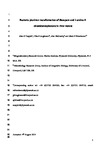Bacterio-plankton transformation of diazepam and 2-amino-5-chlorobenzophenone in river waters.
| dc.contributor.author | Tappin, Alan | |
| dc.contributor.author | Loughnane, JP | |
| dc.contributor.author | McCarthy, AJ | |
| dc.contributor.author | Fitzsimons, Mark | |
| dc.date.accessioned | 2016-03-24T14:52:59Z | |
| dc.date.available | 2016-03-24T14:52:59Z | |
| dc.date.issued | 2016-04-05 | |
| dc.identifier.issn | 2050-7887 | |
| dc.identifier.issn | 2050-7895 | |
| dc.identifier.uri | http://hdl.handle.net/10026.1/4425 | |
| dc.description.abstract |
Benzodiazepines are a large class of commonly-prescribed drugs used to treat a variety of clinical disorders. They have been shown to produce ecological effects at environmental concentrations, making understanding their fate in aquatic environments very important. In this study, uptake and biotransformations by riverine bacterio-plankton of the benzodiazepine, diazepam, and 2-amino-5-chlorobenzophenone, ACB (a photo-degradation product of diazepam and several other benzodiazepines), were investigated using batch microcosm incubations. These were conducted using water and bacterio-plankton populations from contrasting river catchments (Tamar and Mersey, UK), both in the presence and absence of a peptide, added as an alternative organic substrate. Incubations lasted 21 days, reflecting the expected water residence time in the catchments. In River Tamar water, 36% of diazepam (p < 0.001) was removed when the peptide was absent. In contrast, there was no removal of diazepam when the peptide was added, although the peptide itself was consumed. For ACB, 61% was removed in the absence of the peptide, and 84% in its presence (p < 0.001 in both cases). In River Mersey water, diazepam removal did not occur in the presence or absence of the peptide, with the latter again consumed, while ACB removal decreased from 44 to 22% with the peptide present. This suggests that bacterio-plankton from the Mersey water degraded the peptide in preference to both diazepam and ACB. Biotransformation products were not detected in any of the samples analysed but a significant increase in ammonium concentration (p < 0.038) was measured in incubations with ACB, confirming mineralization of the amine substituent. Sequential inoculation and incubation of Mersey and Tamar microcosms, for 5 periods of 21 days each, did not produce any evidence of increased ability of the microbial community to remove ACB, suggesting that an indigenous consortium was probably responsible for its metabolism. As ACB degradation was consistent, we propose that the aquatic photo-degradation of diazepam to ACB, followed by mineralization of ACB, is a primary removal pathway for these emerging contaminants. As ACB is photo-produced by several benzodiazepines, this pathway should be relevant for the removal of other benzodiazepines that enter the freshwater environment. | |
| dc.format.extent | 2227-2236 | |
| dc.format.medium | ||
| dc.language | en | |
| dc.language.iso | en | |
| dc.publisher | Royal Society of Chemistry (RSC) | |
| dc.subject | Bacteria | |
| dc.subject | Benzophenones | |
| dc.subject | Biotransformation | |
| dc.subject | Diazepam | |
| dc.subject | Environmental Monitoring | |
| dc.subject | Plankton | |
| dc.subject | Rivers | |
| dc.subject | Water Pollutants, Chemical | |
| dc.title | Bacterio-plankton transformation of diazepam and 2-amino-5-chlorobenzophenone in river waters. | |
| dc.type | journal-article | |
| dc.type | Journal Article | |
| dc.type | Research Support, Non-U.S. Gov't | |
| plymouth.author-url | http://www.ncbi.nlm.nih.gov/pubmed/25164562 | |
| plymouth.issue | 10 | |
| plymouth.volume | 16 | |
| plymouth.publication-status | Published | |
| plymouth.journal | Environ Sci Process Impacts | |
| dc.identifier.doi | 10.1039/c4em00306c | |
| plymouth.organisational-group | /Plymouth | |
| plymouth.organisational-group | /Plymouth/Faculty of Science and Engineering | |
| plymouth.organisational-group | /Plymouth/Faculty of Science and Engineering/School of Geography, Earth and Environmental Sciences | |
| plymouth.organisational-group | /Plymouth/REF 2021 Researchers by UoA | |
| plymouth.organisational-group | /Plymouth/REF 2021 Researchers by UoA/UoA07 Earth Systems and Environmental Sciences | |
| plymouth.organisational-group | /Plymouth/Research Groups | |
| plymouth.organisational-group | /Plymouth/Research Groups/BEACh | |
| plymouth.organisational-group | /Plymouth/Research Groups/Marine Institute | |
| plymouth.organisational-group | /Plymouth/Users by role | |
| plymouth.organisational-group | /Plymouth/Users by role/Academics | |
| plymouth.organisational-group | /Plymouth/Users by role/Researchers in ResearchFish submission | |
| dc.publisher.place | England | |
| dcterms.dateAccepted | 2014-08-04 | |
| dc.rights.embargodate | 2015-4-4 | |
| dc.identifier.eissn | 2050-7895 | |
| dc.rights.embargoperiod | 12 months | |
| rioxxterms.funder | Natural Environment Research Council | |
| rioxxterms.identifier.project | Bacterial Assimilation of Riverine Organic Nitrogen (BARON). | |
| rioxxterms.versionofrecord | 10.1039/c4em00306c | |
| rioxxterms.licenseref.uri | http://www.rioxx.net/licenses/under-embargo-all-rights-reserved | |
| rioxxterms.licenseref.startdate | 2016-04-05 | |
| rioxxterms.type | Journal Article/Review | |
| plymouth.funder | Bacterial Assimilation of Riverine Organic Nitrogen (BARON).::Natural Environment Research Council | |
| plymouth.funder | Bacterial Assimilation of Riverine Organic Nitrogen (BARON).::Natural Environment Research Council |


